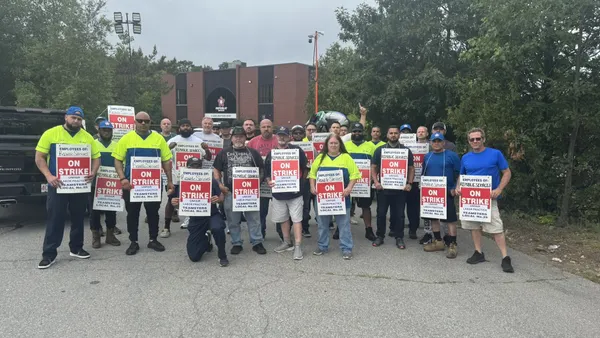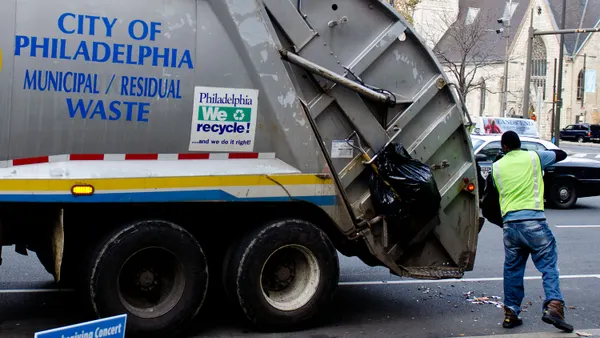While California is often held up as the leading edge of environmental policy when it comes to waste and recycling, Los Angeles hasn't always been part of that Bay Area-centric spotlight. But as the city continues to work toward ambitious recycling targets and adapt to upcoming state regulations, that's likely to change.
A few years back, Los Angeles set a goal of 90% diversion from landfills by 2025 (plus other benchmarks included in the path toward "zero waste"), emphasizing organic waste as a key part of achieving that target. Existing state regulations such as AB 1826 have already helped drive progress in the commercial sector, with more to come as organics requirements kick in for customers under the city's RecycLA franchise program. Once state requirements under SB 1343 — which will eventually mandate progress toward a 75% reduction in organic waste disposal by 2025 — take off, these efforts will reach a whole new level.
Last week, Mayor Eric Garcetti went even further by announcing a "Green New Deal" for the city that includes targets to fully eliminate organic waste from landfills by 2028 and achieve 100% landfill diversion by 2050.
Waste Dive spoke to LASAN Director Enrique Zaldivar in early April before these latest goals were announced in order to learn about his agency's organic waste plans and progress toward "zero waste." You can read the first part of Waste Dive's interview with Zaldivar on how commodity shifts have affected city recycling programs here.
The following conversation has been edited for brevity and annotated for context.
WASTE DIVE: Do you have a sense of what you'd like to see come out of CalRecycle's SB 1383 rulemaking process to fit with what the city is already doing?
ENRIQUE ZALDIVAR: [B]eing able to facilitate the infrastructure that comes with these promulgations. Organics is going to be more challenging even than everything else — the siting of the facilities, the movement of the end product. We have some experience with our own biosolids from our clean water program and having to compete with other composted products or, frankly, finding areas of synergistic addition.
Food waste and organics is definitely going to propel a closer marriage between wastewater processes [and the solid waste sector] ... And we stand in a good position in that we have both under this department. A good example is making use of existing anaerobic digestion capacity, which we intend to do at our water reclamation plants. But it also could help synergies in the composting aspect of it. Those who are going to utilize composting as a strategy, which we will, can now look at co-composting between biosolids and food waste and organics of other types.
[T]he regulatory framework around this, specifically at the state level, is important because it's one thing to have the goals placed on us — but then, if we're unable to have a composting facility within a reasonable distance, does it mean we have to truck it to Arizona? ... Then before you know it, there's a ban on our stuff going to Arizona. So I think we have to depend on things that are within the state, and CalRecycle should play a more active role on that.
One example of public infrastructure to manage organics is the Los Angeles County Sanitation Districts' Puente Hills facility, which will pre-process organics for codigestion — but all involved recognize the need for more regional processing capacity. The RecycLA franchise program has also begun to spur infrastructure investment from service providers and partners.
Do you hope that because everybody knows clearly the state policies are coming, the private sector will step in and sense an opportunity? Or do you think the city will have to build some infrastructure as well?
ZALDIVAR: We would be naive and shortsighted if we felt that all of this needs to happen on the municipal side. I think RecycLA is a good example of private and public participation because one: we benefit from the expertise and bulk. We benefit from the financial capabilities of the private sector. So by no means are we saying that we the cities, or we LA, should build it all, because we know we can't and we shouldn't.
There's an interesting example of a facility east of here in Rialto, called Anaergia. They broke ground just in the last six months — good size investment. [The private sector is] taking a risk by raising the capital, committing to building it, and it's under construction ... some are already committed participants, including some of the RecycLA companies. And we intend to make use of it as well.
In terms of actually collecting the material from its residential customers, LASAN has been exploring in-sink device pilots and curbside service, but hasn't committed to one approach yet.
I remember you telling me curbside is not always going to work with the LA heat, leaving material out for long periods of time. What is the latest thinking on how you're going to get material out of the residential sector to end up in this infrastructure?
ZALDIVAR: [We are very] mindful of all the different components of what is a huge movement to go to organics separation, or organics processing, outside of the black bin. So, mindful of that, we're rolling out a sizable pilot in the residential sector: 20,000 homes where we're going to mix food waste in the green bin.
Number one is utterly to test the customer's acceptability. Number two: to mitigate the potential for issues that are inherent more to the organics and the separated food waste — in the way of odors and the summer heat — by having the green waste act somewhat as a buffer. There's an absorption value that comes with green waste, which will be intermixed.
We don't want to be dismissive of all of the nuances that can make it successful or not, and those are some of those nuances. We can't assume that just because we believe separating organics— and food waste specifically — is a higher calling, that all of our 800,000 customers are going to agree with us. So we have to be deep enough in it that we can sort out those details. Is having the choice of using the bag something that we want to make available or something that the customer would prefer? A lot of folks may not want to have food waste just out in the open, even in the bin. They would rather just have it in the bag, so that's the kind of stuff we're going to test. That rolls out this year.
With the goal of taking those lessons and scaling up from there?
ZALDIVAR: Let's say we do scale it up and go citywide, that's means we're sold on composting, you see?
Because you're mixing with the green waste, versus using anaerobic digestion?
ZALDIVAR: Exactly. We do not know necessarily of a process ... Although we do have one experiment with a company called CR&R, where we have more of a dehydration process that's similar to anaerobic digestion, but may be able to handle the bulkier green waste.
But that's the implications of the decision that's going to be made. It's not like we're afraid of making a decision, it's what decision is it going to be? The decision could very well be that we provide choices to the customers. If we believe that some would rather use the in-sink grinder for food waste, then we want to make that choice available without any guilt associated with it so that the customer feels right about what they're doing — which brings it to the anaerobic digestion capacity at [the Hyperion Water Reclamation Plant] without any more trucks on the road.
Los Angeles finalized its Solid Waste Integrated Resources Plan (SWIRP), which set the original 2025 "zero waste" target, back in 2015. While the city maintains its overall diversion rate is heading in the right direction, many factors have changed in the years since the plan's implementation.
Thinking about the SWIRP benchmarks, do you feel like you're on track?
ZALDIVAR: The markets had been an interesting setback of sorts, because it has caused us to pause — not suspend, not stop, just pause — in our mid-term thinking. Not yet, by any means, saying 2025 is non-achievable. We know the organics program is going to make a big difference. We know that the energy we're putting into adjusting the markets for recyclables, whichever way that's going to be, [will help].
We also see the shifts going on in the product making itself. There's now a trend back to glass — you may have noticed it. Folks are coming back to glass and leaving plastic behind. Plastic inherently has other problems, and how do we adjust to that? We're not dictating the markets. Folks are moving back to glass on their own. My own daughter came home with yogurt in a glass jar.
The conversation turns to packaging trends and, prompted by Zaldivar, the question of extended producer responsibility policies.
We know we have very little, if any, influence there ... whether the product responsibility theory can truly take hold here in this country of free enterprise.
I almost feel as if we're going against our own values, so I don't give that a whole lot of thought. I don't. Although we know that to say, "Well, you shouldn't be producing something that does not already have an end market guaranteed for it" — do we stifle creativity and innovation by having such a thing? I feel like we do.
Zaldivar cites CFL light bulbs as an example of something that, due to their mercury content, might not have taken off as quickly if proven end markets had been required before they became available. Yet, he said, without CFL bulbs serving as a transitional product, the even more efficient LED bulbs — which, Zaldivar notes, has its own end-of-life questions — might not have become as widespread as they are today. A parallel is then drawn to cities slowing expansion of e-scooters and similar devices — which he believes is inevitable — to highlight how his agency must remain adaptive as it continues broader "zero waste" efforts.
So I think we're trying to be best balanced ... I mean, we can aspire for product responsibility to be fully ingrained in our free enterprise culture. Can we truly make it a reality? We can aspire to it. And can we get to the point where before someone introduces a new product, the end of life question is already answered.
And I think we need to keep moving in that direction, but I don't think we can afford to be overly aggressive and make it a mandate now. I just think the entire culture, including the millennials, needs to adjust to that way of thinking. The free enterprise still very much means let innovation drive what happens in product development. But we need to continue to make inroads on that thinking, to the point that when that does become part and parcel of product development, it's not a shock.










